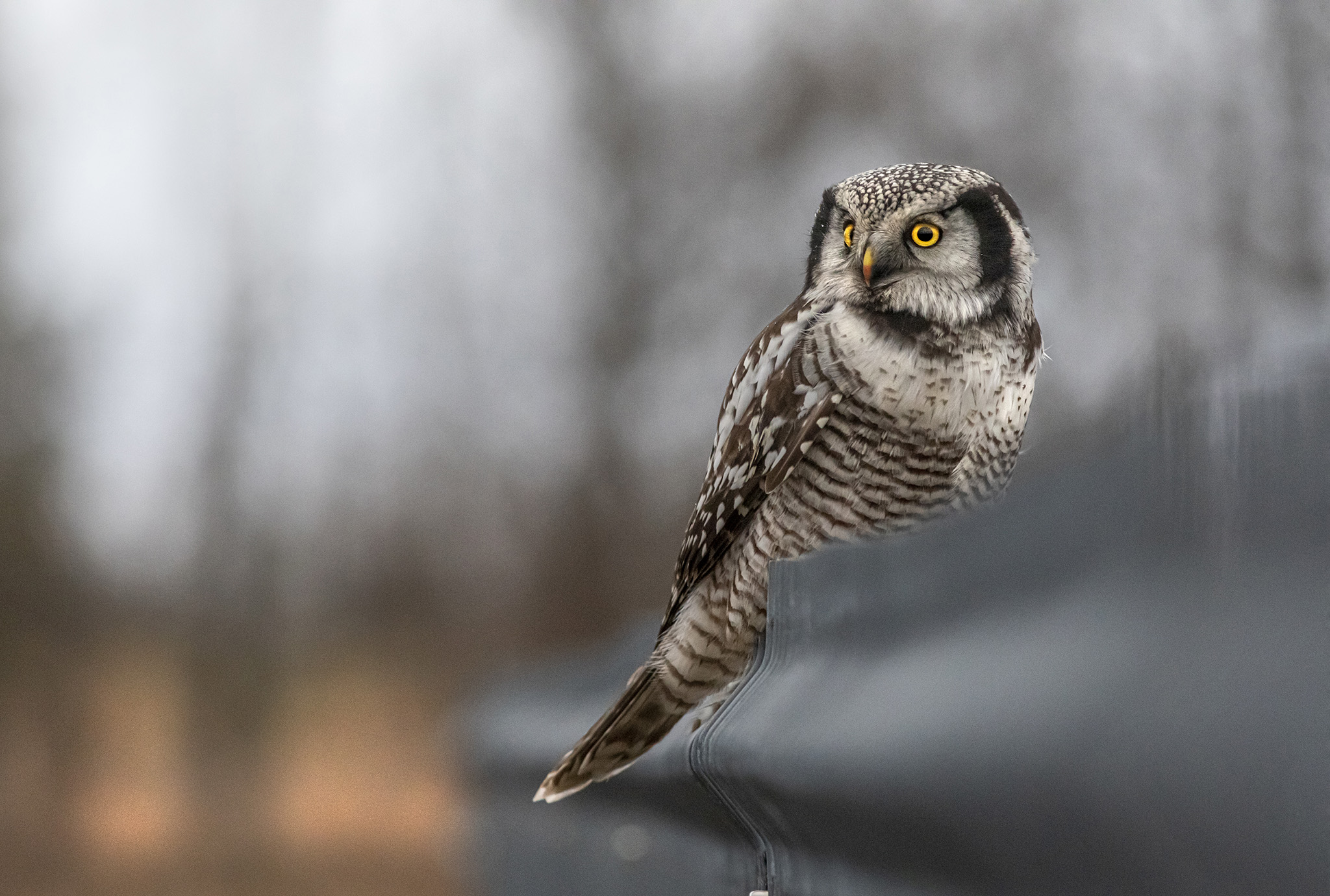The Northern Hawk Owl (Surnia ulula) is a striking and distinctive bird of prey found in the northern regions of Europe, Asia, and North America. Known for its unique appearance and behavior, it is a fascinating species within the owl family.
Description
- Appearance:
- Size: The Northern Hawk Owl measures approximately 35-43 centimeters (14-17 inches) in length, with a wingspan of about 70-90 centimeters (27-35 inches).
- Coloration:
- Head: It has a rounded head with a prominent white face and dark eyes, giving it a somewhat hawk-like appearance.
- Body: The upperparts are mottled with brown and white, while the underparts are white with dark brown streaks. The tail is banded with white and dark brown.
- Legs: It has feathered legs down to the talons, which is typical of many owls but not always of those resembling hawks.
Habitat
- Distribution: The Northern Hawk Owl is found in the boreal forests of northern Europe, Asia, and North America. Its range extends from Scandinavia and the Baltic region across Siberia, and it is also present in parts of Canada and Alaska.
- Preferred Environment: It prefers mature coniferous forests and forest edges. It can also be found in mixed woodlands and occasionally in more open, treed landscapes.
Behavior and Ecology
- Diet:
- Carnivorous: The Northern Hawk Owl primarily preys on small mammals, birds, and insects. Its diet can include voles, mice, small songbirds, and even occasionally larger insects.
- Hunting: It hunts during the day and is known for its active hunting style. It often perches on high vantage points, such as trees or poles, from which it can spot prey.
- Breeding:
- Nesting: Northern Hawk Owls typically nest in tree cavities, abandoned nests of other large birds, or on ledges. They may also use old nests of crows or hawks.
- Eggs: The female lays 3-6 eggs, which are incubated for about 30-32 days. The male provides food for the female during this period.
- Fledging: The young owlets fledge about 28-35 days after hatching, and they remain dependent on their parents for some time after leaving the nest.
- Behavior:
- Diurnal Activity: Unlike many owls, the Northern Hawk Owl is active during the day, particularly during the early morning and late afternoon. This diurnal activity is one of its distinguishing features.
- Vocalizations: It has a variety of vocalizations, including a series of hoots and whistles used for communication between mates and to establish territory.
Conservation
- Status: The Northern Hawk Owl is generally not considered endangered. It has a stable population throughout its range, although it can be locally affected by habitat changes and food availability.
- Conservation Efforts: Protecting its boreal forest habitat and ensuring the availability of prey species are important for maintaining healthy populations. Specific conservation measures are typically focused on preserving large forested areas.
Observing Northern Hawk Owls
- Best Times: The Northern Hawk Owl can be observed year-round in its range, but it is most active and easier to spot during the breeding season in late spring and summer.
- Watching Tips: Look for them perched on high vantage points in forested or open woodland areas. Their distinctive appearance and day-active behavior make them relatively easier to spot compared to many other owls.
Interesting Facts
- Hawk-like Appearance: The Northern Hawk Owl’s appearance, with its striking white face and dark eyes, gives it a resemblance to hawks, which is unusual among owls.
- Daytime Hunting: Its daytime hunting habits set it apart from most other owl species, which are typically nocturnal or crepuscular (active during dawn and dusk).
Summary
The Northern Hawk Owl (Surnia ulula) is a distinctive bird of prey known for its unique appearance, diurnal hunting behavior, and wide distribution in northern forests. Its combination of hawk-like features and owl characteristics make it a fascinating subject for bird enthusiasts and researchers. Its stable population and relatively broad range highlight its adaptability to various forested environments across the northern hemisphere.
Visited 277 times, 8 visit(s) today
Views: 1499
Advertisements
Subscribe to the newsletter:
